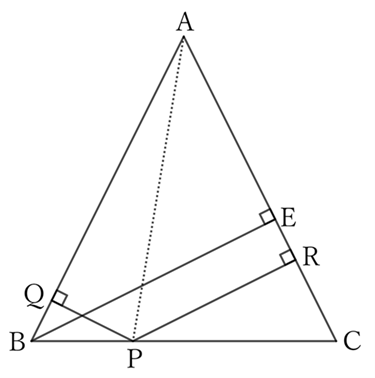Problem
The sum of perpendicular lines $PQ$ and $PR$ drawn from any point $P$ on the base $BC$ of an isosceles triangle $ABC$ with $A$ as its vertex to $AB$ and $AC$ is constant.
$$ $$
$$ $$
$\downarrow$ $\downarrow$ $\downarrow$ $\downarrow$ $\downarrow$
$$ $$
$$ $$
$$ $$
$$ $$
$$ $$
$$ $$
$$ $$
$$ $$
$$ $$
$$ $$
Solution

If we draw a perpendicular line $BE$ from $B$ to $AC$ and connect $A$ and $P$,
$$△ABP=\frac{1}{2}×AB×PQ, \qquad [1]$$
$$△ACP=\frac{1}{2}×AC×PR, \qquad [2]$$
$$△ABC=\frac{1}{2}×AC×BE. \qquad [3]$$
However, since $AB=AC$,
$$△ABP=\frac{1}{2}×AC×PQ. \qquad [1]’$$
Note that
$$△ABP+△ACP=△ABC.$$
Thus, from $[1]’, \ [2]$ and $[3]$,
$$\frac{1}{2}×AC×PQ+\frac{1}{2}×AC×PR=\frac{1}{2}×AC×BE,$$
$$∴ \ PQ+PR=BE.$$
Therefore, wherever $P$ is on $BC$, $PQ+PR$ is always equal to $BE$.
$ $
$ $
$ $
Reference Teiichiro Sasabe (1976) The Encyclopedia of Geometry (2nd edition), Seikyo-Shinsha, p.34.